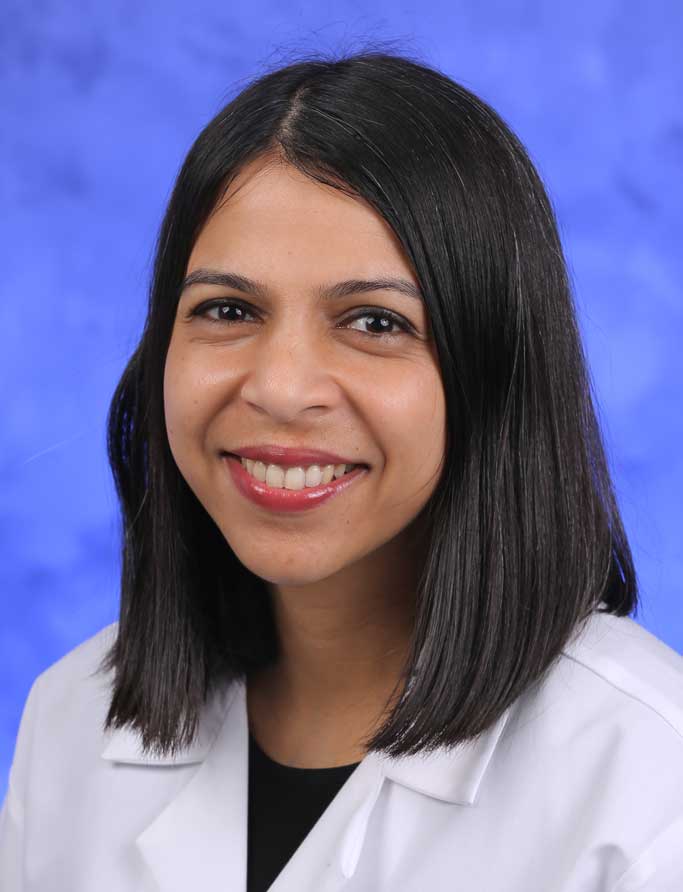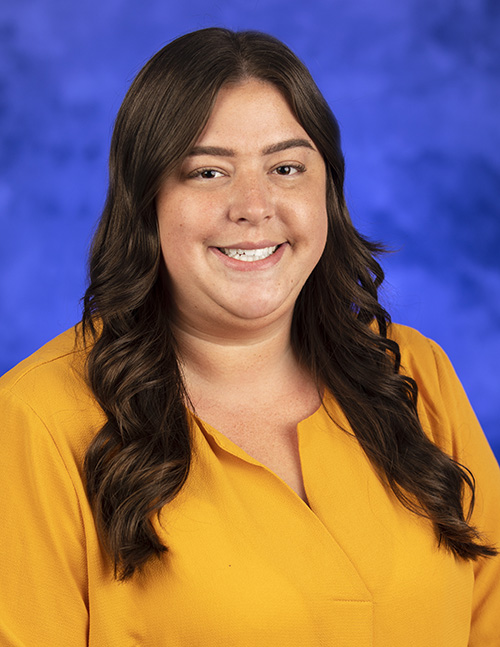Jump to topic
Search
Program Details
The Internal Medicine Residency is proud to train outstanding patient-centered internal medicine physicians. This program strives for excellence in all areas, with residents learning and training in a community of caring, respect, curiosity and innovation.
The residency offers:
- Training opportunities at diverse training sites: Penn State Health Milton S. Hershey Medical Center, Lebanon VA Medical Center, Penn Medicine Lancaster General Hospital and multiple outpatient community sites.
- 4+2+2 scheduling model, allowing to mostly alternate between four weeks of an inpatient service, two weeks of an elective rotation, and two weeks of dedicated time in their ambulatory clinics.
- Protected academic half-day for inpatient and outpatient rotations.
- Opportunity to care for diverse populations as the main quaternary referral center for central Pennsylvania.
- Flexibility for trainees to pursue individualized career goals through training tracks: primary care, hospitalist and longitudinal research. The program also offers the ABIM Internal Medicine Research Pathway and the ABIM Subspecialty Research Pathway.
- Strong subspecialty training with competitive fellowship match placement.
- Collaboration with a longstanding established Medicine/Pediatrics Residency.
- Sense of community facilitated through smaller learning academies consisting of residents, faculty Master Educators and faculty clinical coaches.
- Collegiality among house staff, faculty, nursing staff and the community.
Learn More about the Residency
Program Mission
We are…
- A program that treats you as an individual
- A program that strives for equity, justice, and care for our community
- A program that aims for excellence in innovation to prepare you for the challenges of medicine, both today and tomorrow
- A program that promises to care for you as you care for others
We are… Penn State Internal Medicine Residency Program.
Program Vision
Train here, excel anywhere: Our vision is to be the best internal medicine residency program, fostering innovative physician leaders who embrace growth and excellence, challenge healthcare inequities, care for others and themselves, and transform medicine for the greater good.
Program Highlights
- Master Educator academies: The Internal Medicine Residency has three Master Educator academies with three Master Educator champions. These champions were selected from competitive pool of clinician educators. They promote the residency program vision and goals, set the educational climate and create a respectful clinical learning environment steeped in curiosity, excellence and compassion. They are responsible for the academy conference series, which stimulates high-order learning.
- Coaching program: All residents are paired with clinical coaches to allow for individualized growth in clinical skills over the course of three years. Coaches are responsible for observing residents in the clinical setting and providing feedback. Furthermore, they will meet with each resident individually every two months and do six-month group meetings.
- POCUS: The program introduced a 36-month point-of-care ultrasound curriculum for the 2019-2020 academic year. All residents receive training in this through didactic and hands-on sessions.
- Research: The residency program created a third assistant program director position, the Assistant Program Director for Resident Research and Scholarly Activity, to promote scholarship among residents. This assistant program director is responsible for the Resident Research Forum, the research elective, the research track and the ABIM Research (FasTrack) pathway.
- Protected time for learning: The residency program has two academic half-day sessions weekly that are free of patient care activities: outpatient academic half-day for residents on ambulatory rotations, and inpatient academic half-day for residents on inpatient rotations. These conferences are in addition to the daily noon conference series.
- 4+2+2 scheduling model: Residents mostly alternate between four weeks of an inpatient service, two weeks of an elective rotation and two weeks of dedicated time in their ambulatory clinics. This schedule design gives residents the opportunity to focus on their respective rotations while maintaining continuity of care in the residents’ continuity clinics
- Specialized tracks: The program offers eight internal tracks: Primary Care, Hippocrates Medical Education, Longitudinal Research, ABIM Research, Health Systems Science, Clinician Educator, Hospitalist, and Global Health & Health Inequities.
Recent Innovations
- Comprehensive wellness initiative, including streamlined primary care provider visits for residents, class wellness champions and biannual wellness retreats.
- Dr. Jed Gonzalo, recipient of the AMA Redesigning Residency Initiative Planning Grant, is including the Internal Medicine Residency in developing the systems-based practice competency to develop residents into systems citizens. This is in collaboration with Kaiser Permanente, Geisinger and Allegheny Health Network.
- A communications curriculum has been developed by Dr. Paul Haidet and Dr. Rick Koubek (former chief resident) to teach residents evidence-based communications strategies through deliberate practice. This initiative is supported by the 2018 Picker Gold GME Education Challenge Grant.
- Dr. Ami Dewaters, Associate Professor for the Department of Medicine, has received a planning grant in collaboration with multiple health systems from the AMA Redesigning Residency Initiative, for which she has involved the Internal Medicine Residency in improving systems-based practice competencies and incorporated the design-thinking process in order to create systems-level changes in the clinical learning environment. This is in collaboration with Kaiser Permanente, Geisinger and Allegheny Health Network.
At the Center of Medical Care in the Region
As the primary academic medical center in central Pennsylvania, Penn State Health Milton S. Hershey Medical Center has a catchment area of more than 3 million people. Therefore, residents care for patients with a wide range of complex medical cases. Residents gain experience through the diverse pathology seen in the urban, suburban and rural areas of referral. Expanding partnerships with local hospitals and clinical sites will only increase this exposure in the future. Read more about Penn State Health Milton S. Hershey Medical Center here.
Internal Medicine Residency trainees are integral members of the health care teams in both general and subspecialty medicine, providing comprehensive care to the population of central Pennsylvania. The program fosters a culture of professional accountability, commitment to excellence and collaborative collegiality that works hand-in-hand with individual growth and learning.
Systems That Work
Penn State College of Medicine is one of the national pioneers of health systems science. The overarching goal of health systems science education at Penn State is to help current and future clinicians appreciate the interrelationship of biological, psychological, social and systems issues that influence an individual’s health. Therefore, Internal Medicine Residency trainees feel empowered to recognize barriers and implement change within their current health systems.
Dr. Jed Gonzalo, Associate Dean for Health Systems Science Education for Penn State College of Medicine and Associate Professor of Medicine, has received a planning grant from the AMA Redesigning Residency Initiative to create program that will develop trainees such that they graduate as truly systems-conscious internists.
Dr. Ami Dewaters, Associate Professor for the Department of Medicine, has received a planning grant in collaboration with multiple health systems from the AMA Redesigning Residency Initiative, for which she has involved the Internal Medicine Residency in improving systems-based practice competencies and incorporated the design-thinking process in order to create systems-level changes in the clinical learning environment.
General Application Information
Applications are accepted through ERAS only.
Deadline for applications is Dec. 31, and interviews are by invitation only.
Application Requirements
Priority is given to applications with a minimum USMLE score of 200; however, a committee reviews the entire application and does not base a decision solely upon the USMLE scores. Osteopathic (DO) applicants may submit COMLEX scores in lieu of USMLE scores.
The program requires a chair’s letter plus two additional letters of recommendation to be attached to the ERAS application. In the event a chair’s letter is not available to an applicant, an additional faculty letter of recommendation will be accepted.
The institution sponsors only J-1 visas for international candidates.
Year of graduation should be within five years of date of application.
The NRMP requires all interviewees to receive a copy of the Resident Agreement. The current resident agreement can be found here.
Preliminary Program Requirements
Applicants to other disciplines (i.e., anesthesia, dermatology, neurology, radiology) requiring a preliminary year must submit a separate ERAS application to the Internal Medicine Preliminary Program in addition to the specialty application. Efforts are made to coordinate interview dates with other subspecialty interviews at Penn State Health Milton S. Hershey Medical Center, but cannot be guaranteed. Separate interview dates may not be necessary depending on the specialty program.
For details regarding the program and/or a preliminary program interview, email IMresidency@pennstatehealth.psu.edu.
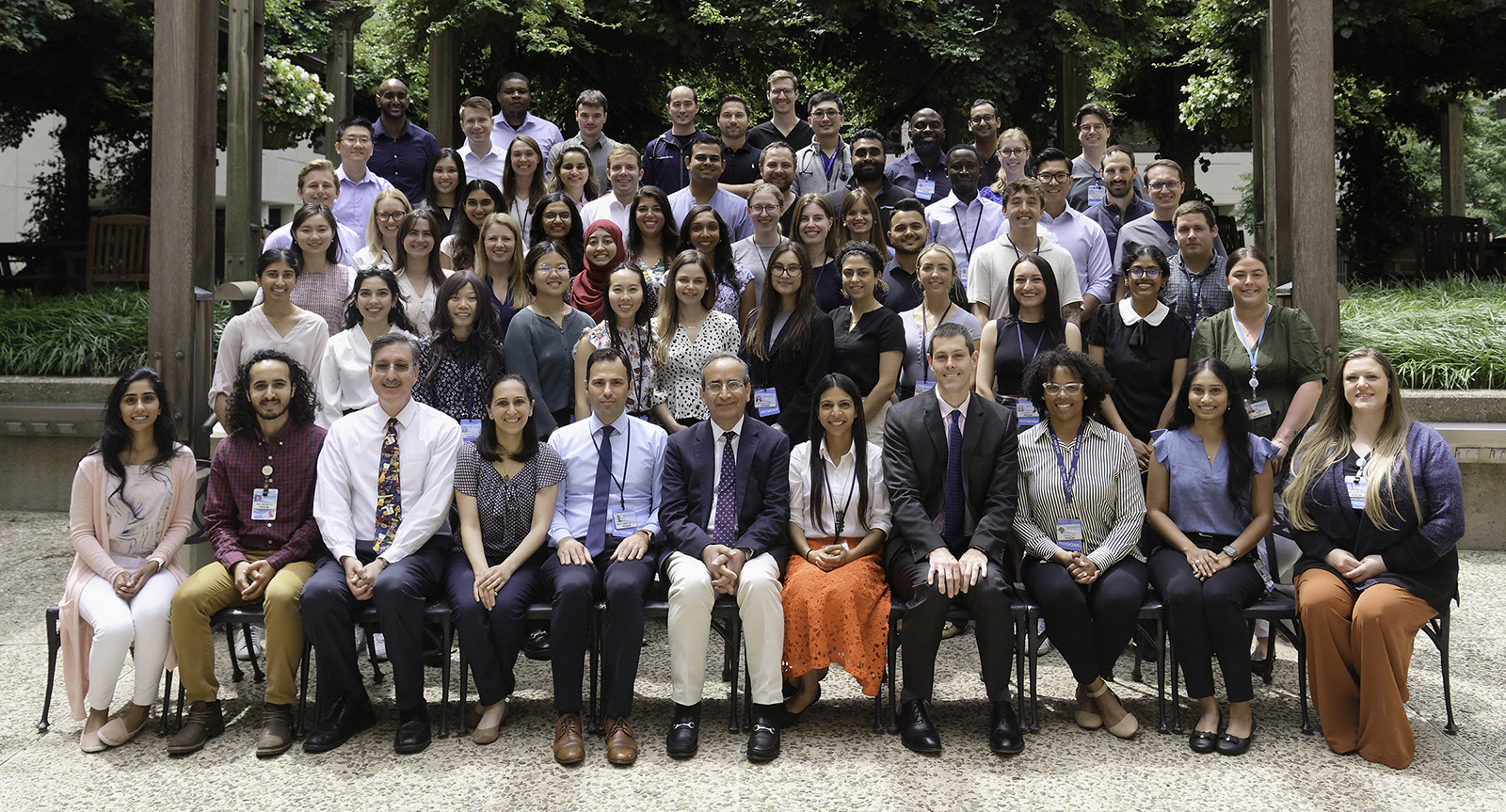
Housestaff, Internal Medicine Residency at Penn State Health Milton S. Hershey Medical Center, 2024-2025
The NRMP Fellowship Match has proven very successful for Penn State’s internal medicine trainees, with an overall success rate of greater than 95 percent. The majority of those who have applied to fellowship have placed in one of their top three program choices even in the most competitive specialties.
Allergy & Immunology
- Thomas Jefferson University – Pennsylvania
Cardiology
- Lankenau Medical Center – Pennsylvania
- University of Rochester/Strong Memorial – New York
- Ohio State University Medical Center
Gastroenterology
- University of South Florida Morsani College of Medicine – Tampa, Fla.
- Wake Forest Baptist Medical Center – North Carolina
Hematology and Oncology
- Penn State Health Milton S. Hershey Medical Center
Medicine/Pediatrics
- Case Western/University Hospital Cleveland Medical Center – Pediatric Hospital Medicine
- University of Texas Southwestern Medical School – Pediatric Hematology/Oncology
- University of Wisconsin Hospital and Clinics – Pediatric Critical Care Medicine
Cardiovascular
- Penn State Health Milton S. Hershey Medical Center
- The Ohio State University
- Thomas Jefferson University (Deborah Heart and Lung Center)
Allergy & Immunology
- Penn State Health Milton S. Hershey Medical Center
- University of Wisconsin
- The Ohio State University
Hematology/Oncology
- Penn State Health Milton S. Hershey Medical Center
Gastroenterology
- Mount Sinai Hospital
Hospice & Palliative Care
- Duke University
Pulmonary/Critical Care
- St. Luke’s Hospital
- Virginia Commonwealth
Addiction Medicine
- Penn State Health Milton S. Hershey Medical Center
Allergy/Immunology
- Penn State Health Milton S. Hershey Medical Center
Cardiovascular Medicine
- Penn State Health Milton S. Hershey Medical Center
- Johns Hopkins Hospital
Endocrinology
- Penn State Health Milton S. Hershey Medical Center
Gastroenterology
- Penn State Health Milton S. Hershey Medical Center
- Zucker School of Medicine at Hofstra/Northwell
Hematology/Oncology
- Thomas Jefferson University
Infectious Disease
- Case Western/University Hospitals Cleveland Medical Center
Hospice and Palliative Medicine
- Orange Park Med Center
Pulmonary/Critical Care
- Ochsner LSU Health Shreveport
- Penn State Health Milton S. Hershey Medical Center
Rheumatology
- Temple University Hospital
- Penn State Health Milton S. Hershey Medical Center
Cardiovascular Medicine
- Penn State Health Milton S. Hershey Medical Center
- Thomas Jefferson University
- NYU Long Island School of Medicine
Endocrinology
- Penn State Health Milton S. Hershey Medical Center
Gastroenterology
- Penn State Health Milton S. Hershey Medical Center
- University of Mississippi Med Center
- Tulane University School of Medicine
Hematology/Oncology
- Penn State Health Milton S. Hershey Medical Center (2)
Nephrology
- Hospital of the University of Pennsylvania
Pulmonary/Critical Care
- Medical University of South Carolina
Rheumatology
- Penn State Health Milton S. Hershey Medical Center
Cardiovascular Medicine
- Penn State Health Milton S. Hershey Medical Center
Gastroenterology
- Penn State Health Milton S. Hershey Medical Center
- Lehigh Valley Hospital
- Guthrie Robert Packer Hospital, PA
Hematology/Oncology
- Thomas Jefferson University, Pennsylvania
- Penn State Health Milton S. Hershey Medical Center
Nephrology
- Cleveland Clinic
Rheumatology
- University of Arizona
Allergy/Immunology
- University of Cincinnati
Cardiovascular Medicine
- Penn State Health Milton S. Hershey Medical Center
- University of California – Irvine
Gastroenterology
- Penn State Health Milton S. Hershey Medical Center
Geriatrics
- Penn State Health Milton S. Hershey Medical Center
Hematology/Oncology
- Penn State Health Milton S. Hershey Medical Center
- George Washington University
Infectious Diseases
- Penn State Health Milton S. Hershey Medical Center
Pulmonary/Critical Care
- Penn State Health Milton S. Hershey Medical Center
- Mayo Clinic
Cardiovascular Medicine
- Penn State Health Milton S. Hershey Medical Center (3)
- The University of Texas Medical Branch (UTMB) – Galveston
Gastroenterology
- Albert Einstein Medical Center
- Penn State Health Milton S. Hershey Medical Center
- SUNY HSC Brooklyn
Geriatrics
- Mayo Clinic
Hematology/Oncology
- Mayo Clinic
Hospice and Palliative Medicine
- Penn State Health Milton S. Hershey Medical Center
Infectious Diseases
- Penn State Health Milton S. Hershey Medical Center
Pulmonary/Critical Care
- The Medical University of South Carolina (MUSC)
Proceeding to Practice
- Hospitalist Medicine (five graduates)
- Primary Care (three graduates)
Allergy/Immunology
- Penn State Health Milton S. Hershey Medical Center (two graduates)
Cardiovascular Medicine
- Penn State Health Milton S. Hershey Medical Center
- The Ohio State University
Gastroenterology
- Penn State Health Milton S. Hershey Medical Center
Hematology/Oncology
- Brown University
- Penn State Health Milton S. Hershey Medical Center
- University of South Florida Morisani
Hospice and Palliative Medicine
- Luke’s – Bethlehem
- UPMC-Altoona
Infectious Diseases
- Hofstra LIJ
Nephrology
- University of Texas HSC-San Antonio
Pulmonary/Critical Care
- Maine Medical Center
- Penn State Health Milton S. Hershey Medical Center
- University of Massachusetts
Proceeding to Practice
- Hospitalist Medicine (three graduates)
- Primary Care (one graduate)
(100 percent match rate)
Cardiovascular Medicine
- Penn State Health Milton S. Hershey Medical Center
- University of Texas-Houston
Gastroenterology
- Allegheny General (two graduates)
- Carilion Clinic-Virginia Tech Carilion School of Medicine
- Emory University
- Penn State Health Milton S. Hershey Medical Center
Geriatrics
- Johns Hopkins
Hematology/Oncology
- Penn State Health Milton S. Hershey Medical Center (two graduates)
Hospice and Palliative Medicine
- University of Virginia
Nephrology
- Yale-New Haven
Pulmonary/Critical Care
- Penn State Health Milton S. Hershey Medical Center (two graduates)
Proceeding to Practice
- Hospitalist Medicine (five graduates)
- Primary Care (one graduate)
Cardiovascular Medicine
- Penn State Health Milton S. Hershey Medical Center (two graduates)
- Medical University of South Carolina
Endocrinology
- Penn State Health Milton S. Hershey Medical Center
Geriatrics
- NY Presbyterian Hospital, Weill Cornell Medical Center
General Internal Medicine
- Penn State Health Milton S. Hershey Medical Center (inaugural position)
- University of Texas-Southwestern
Infectious Diseases
- University of Maryland
Hospice and Palliative Medicine
- Drexel University
Nephrology
- University of Texas-Houston
Occupational Medicine
- University of Utah
Pulmonary/Critical Care
- Penn State Health Milton S. Hershey Medical Center
Rheumatology
- University of North Carolina
Proceeding to Practice
- Hospitalist Medicine (five graduates)
- Primary Care (two graduates)
Allergy/Immunology
- North Shore-LIJ Health System, NIH Physician-Scientist Program T32
Cardiovascular Medicine
- Penn State Health Milton S. Hershey Medical Center (two graduates)
- Thomas Jefferson University
- University of Utah
Gastroenterology
- Geisinger Health System
- Penn State Health Milton S. Hershey Medical Center (two graduates)
Hematology/Oncology
- Penn State Health Milton S. Hershey Medical Center
Hospice and Palliative Medicine
- Community Care of Lancaster
Rheumatology
- Georgetown University
Proceeding to Practice
- Hospitalist Medicine (seven graduates)
Virtual Tour
Penn State Health
Penn State Health is a multi-hospital health system serving patients and communities across 29 counties of Pennsylvania. Its mission is to improve health through patient care, research, education and community outreach.
In December 2017, the system partnered with Highmark Health to facilitate creation of a value-based, community care network in the region. The shared goal of Highmark and Penn State Health is to ensure patients in the community are within:
- 10 minutes of a Penn State Health primary care provider
- 20 minutes of Penn State Health specialty care
- 30 minutes of a Penn State Health acute care facility
Learn more about Penn State Health
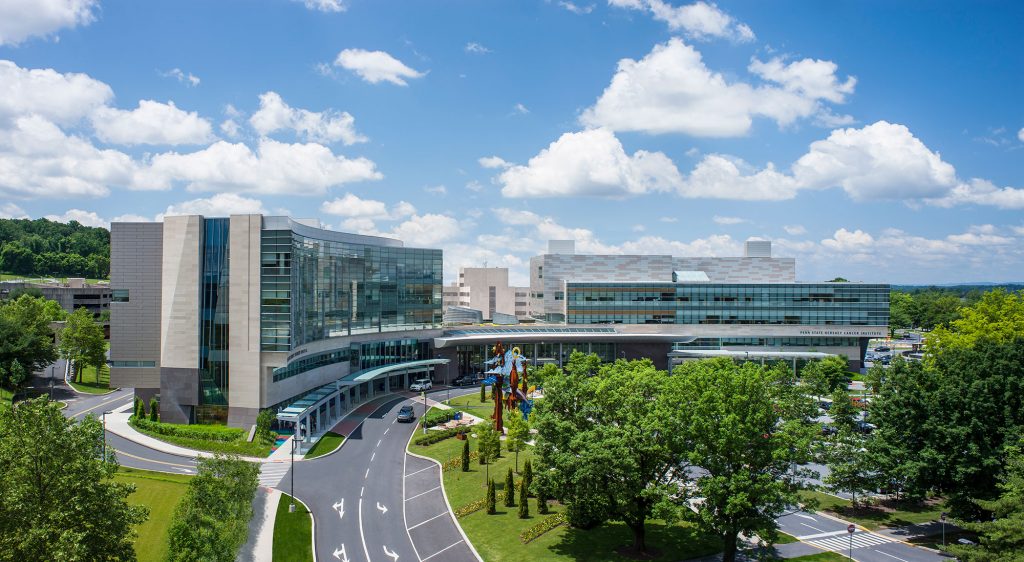
Penn State Health Children’s Hospital (left), Penn State Health Milton S. Hershey Medical Center (center) and Penn State Cancer Institute (right)
Penn State Health Milton S. Hershey Medical Center
500 University Dr., Hershey, Pa., 17033 (Derry Township, Dauphin County)
- The health system’s 647-bed flagship teaching and research hospital
- The only medical facility in Pennsylvania accredited as both an adult and a pediatric Level I (highest-level) trauma center
- Dedicated surgical, neuroscience, cardiovascular, trauma and medical intensive care units
- Accredited Life Lion critical-care transport providing more than 1,100 helicopter and approximately 750 ground ambulance transports per year
- More than 1,300 faculty members and more than 650 residents and fellows
- Approximately 29,000 admissions, 73,000 emergency department visits, 1.1 million outpatient visits and 33,000 surgical procedures annually
- Designated as a Magnet hospital since 2007
Learn more about Milton S. Hershey Medical Center
Penn State Health Children’s Hospital
600 University Dr., Hershey, Pa. 17033 (Derry Township, Dauphin County)
- An eight-story, 263,000-square-foot-facility built in 2013 and expanded in 2020
- 160 licensed pediatric beds, 26-bed pediatric intensive care unit and a 56-bed neonatal intensive care unit
- Level IV (highest-level) neonatal intensive care unit
- Level I quaternary (highest-level) pediatric intensive care unit
- Level I (highest-level) pediatric trauma center designation
- Intermediate care unit
- Dedicated pediatric operating rooms
- More than 150,000 pediatric outpatient visits, 20,000 pediatric emergency room visits, and approximately 5,000 pediatric patient discharges annually
Welcome to Hershey
More About Hershey
Interested in learning more about living and working in Hershey, Pa.? See details here:
Wellness, including emotional, spiritual, social and physical health, is a crucial component to training and to becoming a professional, compassionate and resilient physician. Self-care is a skill which must be continually practiced and reinforced. Penn State College of Medicine and Penn State Health are committed to addressing wellness among residents and fellows, with multiple resources readily available.
Institutional resources
- Visit BeWell – a health program designed to support Penn State Health employees
- See Penn State College of Medicine wellness resources here
- Employee Health Care Concierge and Case Management Service
- Partners in Medicine
Moving to a new city with your family does not have to be stressful. Residency programs have assisted many significant others with finding employment. There is also a GME-Wide Partners in Medicine (PIM) group that offers networking opportunities as well as various social and community oriented activities. - The Doctors Kienle Center for Humanistic Medicine
- Active and easily accessed Office of Professional Mental Health
Graduate medical education resources
Program-Specific Resources
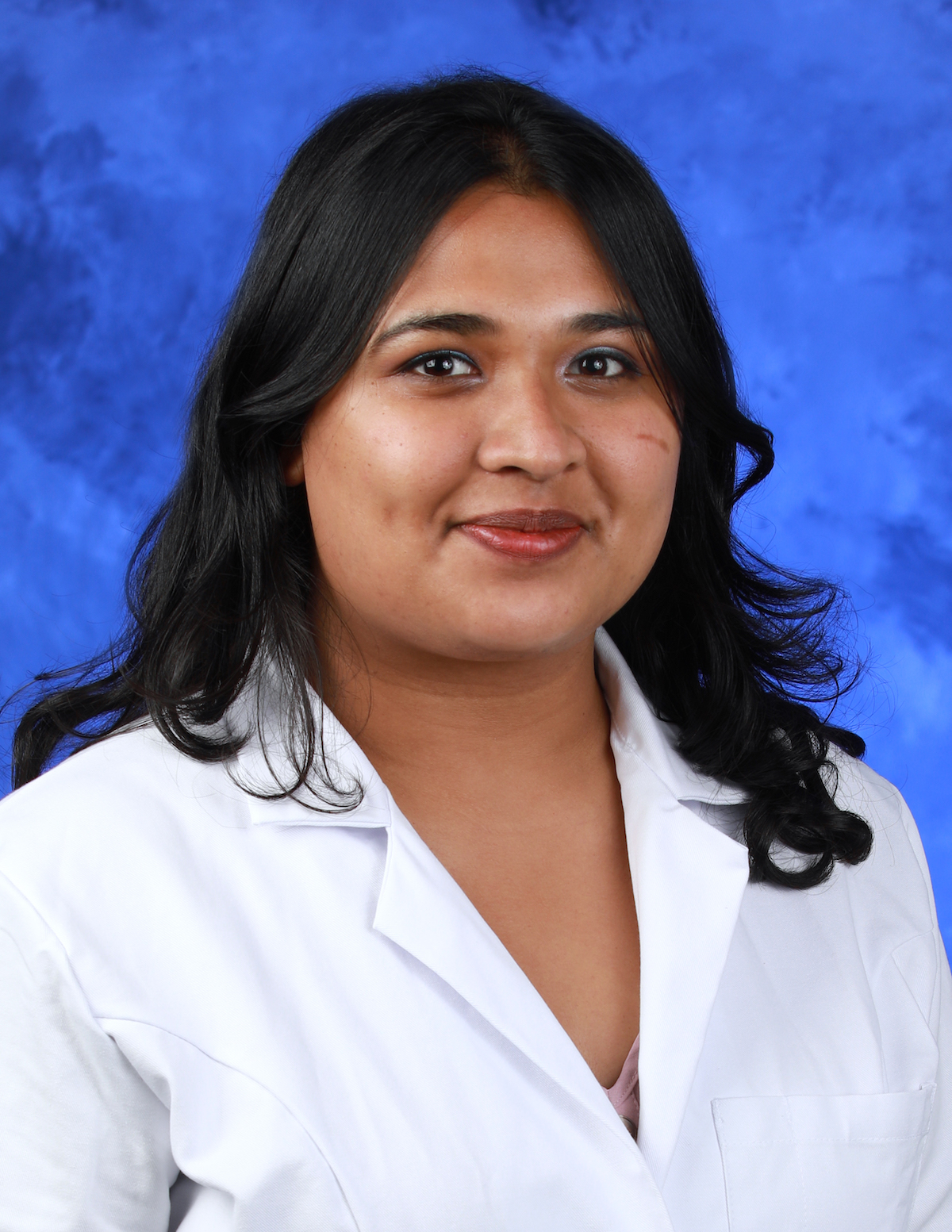
Dr. Priyanka Lakshmanan
Dr. Priyanka Lakshmanan leads all the residents through a longitudinal, year-long wellness curriculum during inpatient academic half-day. She focuses on developing the ability to help recognize burn-out in yourself and others, and subsequently developing mindfulness and resiliency tools.
To supplement the curriculum, each class has a wellness retreat once a year. During the retreat, the class has no clinical duties, goes off-campus, and focuses on team-building and personal resilience strategies.
In addition, residents volunteer to represent their class on the resident Wellness Committee, which is an organization that focuses on planning and implementing wellness activities for all the residents throughout the year.
Institutional Resources
Penn State Health and Penn State College of Medicine celebrate, embrace and support the diversity of all patients, faculty, staff, students and trainees.
Office for Diversity, Equity and Inclusion
In keeping with this, Penn State Health has an active Office for Diversity, Equity and Inclusion with various programs, networks and resource groups, including:
- Talks and lectures on diversity, equity and inclusion through the Inclusion Academy
- Regular events on topics such as eradicating racism and creating a culture of inclusiveness
- Many Business Employee Resource Groups (BERGs), including:
- Disability Business Employee Resource Group
- Interfaith Business Employee Resource Group
- LGBTQ+ Business Employee Resource Group
- Military and Veterans Business Employee Resource Group
- Multicultural Business Employee Resource Group
- NextGen Business Employee Resource Group
- Black Physician Professional Staff Association – Resource Group
- Hispanic Professional Association
- Asian Physician and Professional Staff Association
- International Workforce Inclusion
Learn more about the Penn State Health Office for Diversity, Equity and Inclusion
Learn more about the College of Medicine’s Office for Diversity, Equity and Belonging
Office for Culturally Responsive Health Care Education
The vision at Penn State College of Medicine and Penn State Health is to equip learners with the knowledge, skills and attitudes they will need to provide culturally excellent health care and research for an increasingly diverse U.S. population. The Office for Culturally Responsive Health Care Education was formed to help meet that goal.
Learn more about the Office for Culturally Responsive Health Care Education
Office for a Respectful Learning Environment
In addition, the institution does not tolerate discrimination, biases, microaggression, harassment or learner mistreatment of any kind, and any concerns are immediately addressed by the Office for a Respectful Learning Environment.
Learn more about the Office for a Respectful Learning Environment
Network of Under-represented Residents and Fellows
The Network of Under-represented Residents and Fellows (NURF) is a group of diverse residents and fellows representing all specialties. NURF’s goal is to promote cultural diversity in the residency programs through community involvement, mentorship with diverse faculty, professional networking and support for the recruitment of diverse medical students into the residency programs.
NURF is sponsored by the Penn State College of Medicine Graduate Medical Education Office and the Penn State Health Office for Diversity, Equity and Inclusion.
Learn more information about NURF
Program-Specific Resources
Internal Medicine’s Resident Diversity Equity and Inclusion Council
The Penn State Internal Medicine Residency is committed to supporting and training resident physicians of all backgrounds. In doing so, the Diversity Equity and Inclusion Council aims to create a safe environment with acceptance and celebration of diversity, to provide for the needs of trainees with different heritages and traditions, to promote diversity education in the medical setting and to recruit resident physicians who are underrepresented in medicine or have unique backgrounds.
Here, diversity includes but is not limited to race, ethnicity, religion, gender or gender identification.
The council specifically focuses on:
- Promoting a safe clinical learning environment
- Creating a social space to celebrate diverse backgrounds
- Educating about diversity-related issues
- Recruiting residents of diverse and underrepresented backgrounds
For any questions or concerns, please reach out to the faculty advisors, Dr. Nabeel Akhtar or Dr. Leah Ross.
Mailing Address
Department of Medicine
Penn State Health Milton S. Hershey Medical Center
PO Box 850, Mail Code H039
500 University Dr.
Hershey PA 17033-0850
General Contact Information
Phone: 717-531-6375
Curriculum Details
Residents have a diverse education by experiencing multiple different health care systems.
During training at Penn State, residents will have the opportunity to learn in three different hospital systems: Penn State Health Milton S. Hershey Medical Center, a large, tertiary academic medical center; Lebanon VA Medical Center; and Penn Medicine Lancaster General Hospital, a large community-based hospital.
Explore the next sections to learn more about the clinical schedule, which has a focus on education and wellness.
Block clinic scheduling improves resident satisfaction with the primary care experience. Therefore, the program uses a six-plus-two system in the residency, so that each resident will have six weeks of dedicated inpatient rotations followed by two weeks of rotation in the primary care clinic, a level III patient-centered medical home.
The resident primary care clinic is located at Penn State Health Cocoa Outpatient Center, 1150 Cocoa Ave, Hershey PA, 17033.
The established night float system provides exceptional 24-hour care to all patients. As a result, residents in the program are rarely required to work 24-hour shifts, and call ends at 7 p.m. daily.
The program strongly believes in ensuring that residents have time to dedicate their concentration exclusively to their education. There are established weekly outpatient and inpatient academic half-days during which residents do not have any clinical responsibilities.
The program’s goal is for every resident to have the time and opportunity to explore their clinical and future career interests. Residents receive significant elective time and can choose electives in any subspecialty, including allergy and immunology, cardiology, endocrinology, gastroenterology, hepatology, hematology, infectious disease, oncology, palliative care, pulmonology, rheumatology and more. For those interested in academic careers, there are also electives available in research and medical education.
The clinical curriculum in the Internal Medicine Residency is a journey to becoming an exceptional clinician, educator and scholar.
The Internal Medicine Residency uses an ambulatory block schedule in place of traditional weekly clinic sessions.
This system enables residents to provide longitudinal patient care and reduce the number of clinic sessions during busy inpatient rotations, while still meeting ACGME requirements for outpatient training. This has significantly increased residents’ satisfaction with ambulatory training.
During any two-week ambulatory block, residents provide longitudinal care for their patients in the primary care clinic but also spend time in other subspecialty clinics in order to experience the full spectrum of outpatient care and prepare for a career in primary care or any other subspecialty.
Each ambulatory block has a general theme, based on the predominant area of outpatient medicine that it focuses on. For example, the musculoskeletal block includes exposure to sports medicine, rheumatology, podiatry and spine clinic. The hematology/oncology block includes sessions in palliative care clinic and clinical pathology, besides hematology and oncology clinics. Other outpatient blocks have a predominant focus on women’s health, endocrinology, gastroenterology, cardiology, geriatrics, allergy and immunology, mental health and so on.
The ambulatory curriculum also includes sessions in outpatient procedure clinic, clinic for the underserved, adolescent weight management clinic and the hospital Morbidity and Mortality conference.
The ambulatory blocks include protected time for self-study, quality improvement projects, as well as half a day per week purely dedicated to medical education (academic half-day).
The academic half-day features parts of the innovative curriculum in Evidence-Based Medicine (EBM modules and EBM consult) and the ACP High-Value Cost-Conscious curriculum. During the academic half-day, residents engage in problem-based learning and have the opportunity to assume the role of teachers for their peers.
Direct observations (mini-CEX) and resident evaluations are integrated into the residents’ outpatient clinic schedule and allocated specific time, which ensures their completion.
The longitudinal care clinic is a level III patient-centered medical home and is supported by an experienced staff. Residents treat patients with a wide variety of disorders, ranging from routine primary care and prevention to more complex and esoteric problems. Residents also enjoy a very low patient no-show rate in their clinic, which allows them to quickly build and follow a patient panel.
Under the leadership and support of former Chair of Medicine, Dr. Thomas Ma, the residency program developed an academy-based system of master educator champions and coaches to guide residents in their lifelong Internal Medicine education and career development. Each resident is assigned to one of three academies upon arrival at Hershey, and then is assigned a personal coach.
Programs features include:
- Bimonthly educational conferences within the specific academy designed and led by one of three master educator champions.
- Longitudinal, protected relationships between residents and faculty members, designed to address learner-driven coaching and mentoring needs. This may include self-identified areas of learning need, work-life balance, career planning including networking support and scholarship.
The Woodward Center for Excellence in Health Sciences Education offers programs for residents and faculty to strengthen their skills as educators, preparing interested residents more completely for a career in academic medicine. The Internal Medicine Residency partners with the Woodward faculty to provide a robust offering of Residents as Educators curriculum across the three years of training.
The Internal Medicine Residency places a strong emphasis on the EBM training of residents. The multi-faceted curriculum, which extends beyond traditional Journal Club, includes:
- EBM scripts during outpatient academic half-day that enable residents to discuss important EBM concepts such as surrogate outcomes and hierarchy of evidence, without being limited to a particular research study. EBM scripts are based on clinical scenarios and teach such concepts in an interactive manner.
- EBM consults during academic half-day, which are short (10- to 15-minute) presentations from senior residents, each tasked with answering a clinical question. Residents practice formulating a question, searching and appraising the literature and discussing findings with their peers. This format allows residents to become familiar with sources of original research studies but also pre-appraised information such as the PIER modules, TRIP database, etc.
- EBM mini-CEX allows senior residents to practice the application of EBM principles in real time, while caring for their clinic patients.
The Penn State Internal Medicine Residency takes great pride in its formal teaching sessions. Balancing service and education is a common goal for residencies across the country, but this program expects that with a culture of consciously placing resident education first, resident training will only be made better. The Internal Medicine Residency believes formal teaching sessions should exemplify current learning theory of learner-driven topics that utilize interleaved sessions of interactive teaching with small-group case-based education and a consistent use of retrieval practice.
Resident Report
Resident report is held noon to 1 p.m. Mondays, Tuesdays, Wednesdays and Fridays. The Internal Medicine chief residents guide facilitated discussions and presentations about various aspects of residents’ clinical scenarios. Particular Wednesdays throughout the year are also used for the ultrasound curriculum, health systems and quality improvement sessions and Resident Olympics.
Academic Half-Day
Academic half-day is a weekly teaching session in both the inpatient and ambulatory settings. Both inpatient and outpatient academic half-days feature protected time for active learning, residents-as-teachers sessions and subspecialist-led discussions of practice-relevant topics. Sessions vary in topic and style from week to week, but help residents prepare for the ABIM board exam and their future careers in general or subspecialist medicine. The primary method of teaching is small-group case-based learning, with a variety of generalist, subspecialist or chief-resident session leaders.
Academy Conferences
The Penn State Academy system is designed to provide resident coaching and be the vanguard of the educational climate of the residency. Academy conferences are held every two weeks in three concurrent small groups of the resident academies in Master Educator-led academy conferences. Residents and Master Educators use clinical cases to investigate broader clinical questions, health systems and decision-making skills.
Grand Rounds
Tuesday mornings are reserved for Department of Medicine Grand Rounds. Here, invited guest speakers and internal experts present new research developments, updates on best clinical practice and other topics of interest from the broad realm of internal medicine.
Morbidity and Mortality Conference
This conference is a peer-protected conference to evaluate cases with unexpected complications in order to provide education and develop multidisciplinary quality improvement projects. The Morbidity and Mortality Conference focuses on providing a safe forum for many interprofessional disciplines to identify ways to provide better care. Most cases are identified by residents, presented by the chief residents and integrated directly into quality improvement projects.
The Internal Medicine Residency has a rich history of resident research and scholarly pursuits. Resources such as the annual Resident/Fellow Research Day allow residents interested in scholarly activity opportunities to produce high-quality, peer-reviewed projects.
The majority of residents complete their training with achievements in the areas of research, publications and podium/poster presentations at regional, state, national and international levels. In addition to the research elective offered to PGY-2 and PGY-3s residents, opportunities such as the Longitudinal Research Track allow residents interested in pursuing research as a career protected time to devote to longitudinal research projects.
As an example, in recent years, residents have presented at the following national and local meetings:
- Allergy, Asthma, and Immunology
- American Association for Bronchology and Interventional Pulmonology
- American College of Cardiology
- American College of Gastroenterology
- American College of Rheumatology
- American College of Physicians Regional and National Conference
- American Heart Association
- American Society of Nephrology
- American Thoracic Society and CHEST
- Inflammatory Bowel Disease International Conference
- International Academy of Cardiology
- Penn State Annual Resident/Fellow Research Day and Quality Symposium
- Pennsylvania Medical Society
- Society of Critical Care Medicine
- Society of General Internal Medicine
- Society of Hospital Medicine
For those residents who wish to pursue careers with independent research programs, the program also sponsors the ABIM Internal Medicine Research Pathway and the ABIM Subspecialty Research Pathway.
The institutional Physician Scientist Training Program is also available as a resource for career development.
Educational Tracks
Internal Medicine residents apply for specialized tracks during the PGY-1 year.
The primary care track is for residents interested in pursuing careers in primary care or ambulatory-based subspecialties. Residents focus on clinical and non-clinical skills needed to achieve excellence in ambulatory medicine and become part of a community of primary care champions. PCT residents still experience a strong core of inpatient rotations but have increased exposure to ambulatory electives in various settings. Residents also engage in a second longitudinal clinic with an experienced outpatient physician who serves as a key professional mentor.
Primary features
- Population health elective block(s)
- Career exploration blocks tailored to the resident’s particular area of interest
- 2-year health systems science curriculum applied to primary care
- Ambulatory quality improvement initiatives
- Community-building activities
In the hospitalist track, the program emphasizes training hospitalists who can succeed in the rapidly growing field of hospital medicine by putting patient-centered care first, building inter-professional care teams and working and thinking in a systems-based mindset.
Primary features
- Increased rotation time spent in hospitalist medicine
- Increased exposure to rotations where residents work independently as hospitalists
- Opportunity to participate in quality improvement and systems-based curricula
- Rotations on post-acute care
- Opportunities to serve on institutional committees
This longitudinal track creates a community of practice for residents across specialties interested in academic medical education. Monthly sessions and individual mentoring enhance skills in curriculum design, promote discussion on advanced teaching topics, encourage collaborative educational research projects, and prepare participants for careers in academic medical education.
This research track offers residents the opportunity to develop and work on research projects of their choice for a dedicated period of time in order to further their career as a junior clinician investigator.
Primary features
- Applicants are granted 12 weeks of research time between PGY-2 and PGY-3 years
- Research must be completed at PSU under the guidance of a PSU faculty mentor
- Residents continue in the 6+2 block scheduling structure and are expected to participate in their longitudinal clinic
- Monthly progress reports are required to be submitted to Research APD
- Results should be submitted for publication to a peer-reviewed journal or presented at a national conference
- Residents that participate and successfully complete this track will receive recognition during graduation and in letters of recommendation
Project Examples
These projects show the type of work that has been accepted for this track.
Project title: Molecular Profiling of Gastric and Esophageal Carcinoma Cases: Examining Biomarkers with Potential Therapeutic Implications.
Description: An investigative case series of biomarker profiles in gastric and esophageal carcinoma with associated treatment responses. The study aims to show associations between four targeted genes and chemotherapy response.
Project title: Cytokine Expression Profiles in Ulcerative Colitis: Providing Personalized Care and Predicting Treatment Responses
Description: A translational research project to determine whether gene expression of inflammatory mediators in colon tissue can be used as an assay to objectively measure, quantify, and characterize inflammation in ulcerative colitis.
The Internal Medicine Residency offers the American Board of Internal Medicine Research Pathway.
This program includes:
- Accelerated residency training (two years)
- $20,000 per year per resident/fellow for lab equipment and supplies support
- Conditional acceptance into subspecialty fellowships at time of residency acceptance
- 36 months of protected mentored research during fellowship training
- Pathway to faculty appointment at end of training
The HSSA is designed to develop teachers and role models in Health Systems Science within each department who will guide the new learning and practice models that are evolving for increasingly complex population-focused healthcare systems.
Six Domains of Health Systems Science:
- Population and Public Health
- Healthcare Policy, Economics and Management
- Clinical Informatics and Health Information Technology
- Value-Based Care
- Health System Improvement
- Healthcare Delivery Structures and Processes
During the PGY-3 year, HSS Track residents participate in HSS electives that both build on personal interests in health systems and provide direct HSS consults to inpatient medical teams to illustrate health systems concepts in action.
Flexible curriculum for residents desiring longitudinal teaching and curriculum skill development that combines experiences offered by the Woodward Center and the Office of Graduate Medical Education. Participants are individually mentored to create a teaching session and reflect upon their teaching experiences.
The Global Health and Health Inequities Track is available to PGY-2 and PGY-3 residents interested in exploring careers in global health or for people interested in serving underserved populations. Residents can achieve important skills in caring for vulnerable populations nationally and abroad.
Primary Features
- Travel nationally or abroad to underserved areas (2 weeks in PGY-2 year and 4 weeks in PGY-3 year)
- A second continuity clinic site at a community you practice matched to your area of interest
- A two-year curriculum partnered with the Global Health Scholars Program through the College of Medicine
- Participation in a global health or health inequity project
- Community engagement activities
Resident Honors and Recognitions
Penn State College of Medicine and Penn State Health Milton S. Hershey Medical Center accept ongoing nominations for the Exceptional Moments in Teaching award.
The award, given monthly by the Office for a Respectful Learning Environment, accepts nominations from College of Medicine students who are invited to submit narratives about faculty members, residents, fellows, nurses or any other educators who challenge them and provide an exceptional learning experience. See more about the award here.
Previous nominees from the Internal Medicine Residency are listed here. Click the + next to a nominee name to read their nominator’s comments.
The annual Resident/Fellow Research Day is held each year (with exception of during the COVID-19 pandemic) on and around the Penn State Health Milton S. Hershey Medical Center campus.
The intent of the event is to provide an opportunity for residents and fellows to showcase their research accomplishments to their peers in other clinical departments, as well as their colleagues in the basic sciences.
Learn more about Resident/Fellow Research Day here.
Previous presentations from the Internal Medicine Residency are listed here.
Latest News from Internal Medicine




